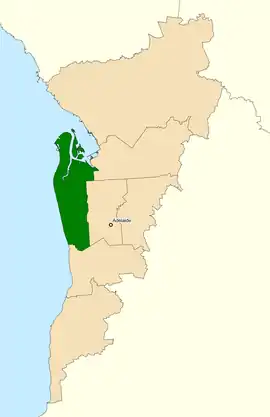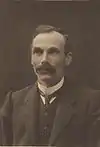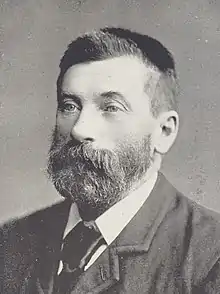Division of Hindmarsh
The Division of Hindmarsh is an Australian Electoral Division in South Australia covering the western suburbs of Adelaide. The division was one of the seven established when the former Division of South Australia was split on 2 October 1903, and was first contested at the 1903 election, though on vastly different boundaries. The Division is named after Sir John Hindmarsh, who was Governor of South Australia from 1836 to 1838. The 78 km² seat extends from the coast in the west to South Road in the east, covering the suburbs of Ascot Park, Brooklyn Park, Edwardstown, Fulham, Glenelg, Grange, Henley Beach, Kidman Park, Kurralta Park, Morphettville, Plympton, Richmond, Semaphore Park, Torrensville, West Beach and West Lakes. The Adelaide International Airport is centrally located in the electorate, making noise pollution a prominent local issue, besides the aged care needs of the relatively elderly population − the seat has one of Australia's highest proportions of citizens over the age of 65. Progressive boundary redistributions over many decades transformed Hindmarsh from a safe Labor seat in to a marginal seat often won by the government of the day.
| Hindmarsh Australian House of Representatives Division | |
|---|---|
 Division of Hindmarsh in South Australia, as of the 2019 federal election | |
| Created | 1903 |
| MP | Mark Butler |
| Party | Labor |
| Namesake | Sir John Hindmarsh |
| Electors | 128,814 (2022) |
| Area | 78 km2 (30.1 sq mi) |
| Demographic | Inner metropolitan |
Geography

Since 1984, federal electoral division boundaries in Australia have been determined at redistributions by a redistribution committee appointed by the Australian Electoral Commission. Redistributions occur for the boundaries of divisions in a particular state, and they occur every seven years, or sooner if a state's representation entitlement changes or when divisions of a state are malapportioned.[1]
Though initially based on the greater Port Adelaide area to the north of the present boundary, now represented by the Division of Port Adelaide, Hindmarsh has long been dominated by working-class families and aged pensioners. Redistributions from the late 1940s onward have moved Hindmarsh clear of its initial boundaries over time to include increasingly wealthy seaside suburbs in and around Glenelg and the Holdfast Bay area to the south.
With only the two additional seats of Adelaide and Boothby covering the metropolitan area until 1949, the south-east state border rural seat of Barker was then considered a "hybrid urban-rural" seat, stretching all the way from the southern tip of South Australia at least as far as Glenelg and the Holdfast Bay area, and at times even stretched as far as the western metropolitan suburbs of Keswick and Henley Beach. After 1949 some of the area had variously been covered by Boothby, Kingston and now-abolished Hawker. The present Hindmarsh has changed little geographically since neighbouring Hawker was abolished in 1993, though the north-western coastal strip was added from 2004.
Though now a marginal seat, for nearly a century it had been one of the safest Labor seats in the country, and was in Labor hands for all but three years from the 1903 election to the 1993 election. As a measure of the strength of Labor support at the time, it was the only seat in the state won by Labor in the massive United Australia Party landslide of 1931. One of the few times that Labor's hold on the seat was seriously threatened in this time came in 1966, when the Labor margin was pared down to 1.7 percent. Even then, sitting member Clyde Cameron still won enough primary votes to retain the seat outright.
Prominent members
Prominent members for the electorate have included Norman Makin, who was Speaker in the Scullin government, and a cabinet minister in the Curtin and Chifley governments, and Clyde Cameron, who was a cabinet minister in the Whitlam government.
Later years
A redistribution ahead of the 1984 election made Hindmarsh far less safe for Labor. From then on, successive redistributions gradually gave it a voting pattern similar to mortgage belt seats, which tend to be fairly marginal.
Labor's hold on the seat became even more tenuous in the redistribution prior to the 1993 election when it absorbed most of the area around Holdfast Bay that had previously been in abolished Hawker. This reduced Labor's two-party margin from an already marginal 5.3 percent to a paper-thin one percent. Combined with state-level anger at the time stemming from the State Bank Collapse, this was enough for Liberal Chris Gallus, previously the member for Hawker, to win the seat in 1993 with a one percent two-party margin from a two percent two-party swing, becoming only the second non-Labor MP ever to win it. She seemingly consolidated her hold on the seat at the 1996 election amid her party's large victory that year, increasing her margin to 8.1 percent – easily the strongest result for a non-Labor candidate in the seat's history.
Gallus fended off spirited challenges from Labor's Steve Georganas at both the 1998 election and 2001 election, winning each time with a margin of less than two percent. When Gallus retired at the 2004 election, Georganas won the seat on a razor-thin 0.06 percent two-party margin from a one percent two-party swing, defeating Liberal candidate Simon Birmingham. Georganas substantially increased his two-party margin above five percent at both the 2007 election and the 2010 election. Though Georganas was thought to have built up a base with the substantial Greek community in Hindmarsh (he is himself of Greek descent), he was defeated at the 2013 election when Liberal Matt Williams won the seat with a 1.89 percent margin from a 7.97 percent two-party-preferred swing. He became its third non-Labor member, and the first to oust a sitting Labor MP in the seat. The only South Australian seat to change hands in 2013, Hindmarsh became the most marginal seat in South Australia, and the only marginal Liberal seat in the state, only to be won back by Georganas for Labor at the 2016 election.
Being the only South Australian seat changing hands and won by the incoming government in 2013, coupled with being the only South Australian seat changing hands in 2016 aside from Mayo, underscored the marginal seat volatility of present-day Hindmarsh. Not a bellwether electorate however, ABC psephologist Antony Green listed the nearby Division of Makin as one of eleven seats throughout Australia which he classed as bellwethers in his 2016 pre-election guide, and was the only bellwether outside of New South Wales and Queensland.[2]
2016 election
South Australian Senator Nick Xenophon confirmed in December 2014 that by mid-2015 the Nick Xenophon Team (NXT) party would announce candidates in the South Australian Liberal seats of Hindmarsh, Sturt and Mayo, along with seats in all states and territories at the 2016 federal election, with Xenophon citing the government's ambiguity on the Collins-class submarine replacement project as motivation.[3] ABC psephologist Antony Green's 2016 federal election guide for South Australia stated NXT had a "strong chance of winning lower house seats and three or four Senate seats".[4] The NXT candidate in Hindmarsh was Daniel Kirk.[5]
Going into the 2016 election with a slender 1.9 percent two-party Liberal margin, Hindmarsh was the most marginal seat in South Australia, the government's only marginal seat in South Australia, the Coalition's only gain at the 2013 election in South Australia, and was the sixth most marginal Coalition-held seat in the nation. Georganas sought to retake the seat from Williams.[6] A Galaxy seat-level opinion poll of over 500 voters in Hindmarsh conducted a week out from the Saturday 2 July election indicated a knife-edge 50–50 two-party vote.[7] Ultimately, NXT preferences allowed Georganas to reclaim Hindmarsh for Labor with a two-party margin of just 0.6 percent, representing a two-party swing of 2.5 percent.[8] Though slender, Georganas was first elected to Hindmarsh at the 2004 election with a two-party margin of just 0.06 percent.[9]
2018 redistribution and 2019 election
Hindmarsh's character was significantly altered in a redistribution ahead of the 2019 federal election. Neighbouring Port Adelaide was abolished, with the bulk of its territory transferred to Hindmarsh; as mentioned above, Hindmarsh had been based on Port Adelaide for much of the first half-century after Federation. At the same time, the Holdfast Bay area was transferred to Boothby. This had the effect of making Labor's hold on Hindmarsh much more secure; on the new boundaries, Labor's margin increased from 0.6 percent to a notional 8.2 percent.[10] At the 2019 federal election, Georgeanas contested the neighbouring seat of Adelaide where Labor incumbent Kate Ellis was retiring, to allow the former member for Port Adelaide, Mark Butler, to follow most of his constituents into the changed Hindmarsh.[11]
Members
Election results
| Party | Candidate | Votes | % | ±% | |
|---|---|---|---|---|---|
| Labor | Mark Butler | 46,547 | 42.18 | −0.91 | |
| Liberal | Anna Finizio | 36,072 | 32.69 | −4.06 | |
| Greens | Patrick O'Sullivan | 15,310 | 13.87 | +2.89 | |
| One Nation | Walter Johnson | 4,341 | 3.93 | +3.93 | |
| United Australia | George Melissourgos | 3,896 | 3.53 | −0.81 | |
| Animal Justice | Matt Pastro | 2,340 | 2.12 | −0.83 | |
| Great Australian | Jamie Witt | 1,184 | 1.07 | +1.07 | |
| Australian Federation | Dianne Richards | 653 | 0.59 | +0.59 | |
| Total formal votes | 110,343 | 94.29 | −1.39 | ||
| Informal votes | 6,686 | 5.71 | +1.39 | ||
| Turnout | 117,029 | 90.98 | −1.87 | ||
| Two-party-preferred result | |||||
| Labor | Mark Butler | 65,043 | 58.95 | +2.41 | |
| Liberal | Anna Finizio | 45,300 | 41.05 | −2.41 | |
| Labor hold | Swing | +2.41 | |||
References
- Muller, Damon (14 November 2017). "The process of federal redistributions: a quick guide". Parliament of Australia. Retrieved 19 April 2022.
- The Bellwether Contests: Antony Green ABC
- Subs backlash, Nick Xenophon sets sights on Liberal-held seats in Adelaide: SMH 6 April 2015
- Election Guide (SA) - 2016 federal election guide: Antony Green ABC
- 2016 NXT candidates: NXT.org.au Archived 23 December 2015 at the Wayback Machine
- Georganas elected unopposed: Neos Kosmos 3 September 2015
- Exclusive poll shows Hindmarsh sits on knife edge, while Liberals look safe in Boothby: The Advertiser 24 June 2016
- Hindmarsh, SA - 2016 Tally Room: Australian Electoral Commission Archived 2016-08-05 at the Wayback Machine
- Hindmarsh, SA - 2004 Tally Room: Australian Electoral Commission
- "2017-18 Federal Redistribution - South Australia". ABC Elections. 26 June 2018.
- Labor's factions negotiate deal to keep Mark Butler in parliament: ABC 18 July 2018
- Hindmarsh, SA, 2022 Tally Room, Australian Electoral Commission.








